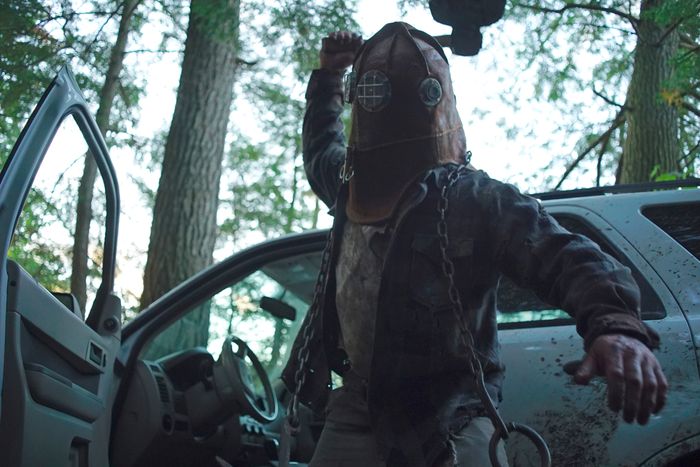
In a Violent Nature is a horror-geek thought experiment that’s only transmuted into something more substantial by its ending. The feature debut from writer-director Chris Nash, it’s about the parts of a slasher movie we don’t normally get to see — which, for most of its run time, means the lulls between murders. Vacationing teens have stumbled across a mysterious locket hanging from the wreckage of a fire-lookout tower and, in taking it, have unwittingly resurrected a hulking revenant named Johnny (Ry Barrett) who then menaces the group in the Ontario woods. The kids are standard fodder for dying at the end of something sharp, young and pretty and so consumed with bickering and flirting that they don’t notice at first that some of their friends have gone missing. But we only overhear their interpersonal dramas when Johnny stalks close enough to scope them out as potential victims, because it’s not their clique that the movie is interested in.
It’s Johnny who the camera glides alongside as he’s guided by his inexorable will to kill. For the most part, what we see is the back of his bulk, draped in rotting flannel and an antique protective mask, as he trudges through sun-dappled woodlands over long takes. What we hear is the hum of insects and chirping of birds, because Johnny, being an undead embodiment of revenge, isn’t much of a talker. The experience of watching In a Violent Nature would be downright meditative if it weren’t for the spectacularly gruesome nature of the kills, which give the game away. Nash has cited Elephant and Gerry as among his inspirations, but those Gus Van Sant films deployed banality for very specific ends, showing how the presumption of safety could be ripped away without advance warning. For most of In a Violent Nature, tedium is really just an aesthetic, and the extremity of its gore — skulls bisected at the jawline, limbs methodically sheared, and an act with a hook I can’t even begin to describe — is the reward for putting up with it.
It’s only the conclusion that uses that unblinking gaze for something more haunting, and that’s because the film breaks format and leaves Johnny behind to follow Kris (Andrea Pavlovic), who emerges as the designated final girl. Given the way that In a Violent Nature is structured, we’ve had no more reason to be invested in Kris than we have the other characters who’ve met unfortunate ends, and she doesn’t take a sudden turn to the heroic when she finds herself the last member of the group standing. Instead, she abandons whatever plan she and her recently slaughtered friend had come up with to seal Johnny away, ditches the locket in hopes that it will appease the monster, and flees. The film stays with her as she careens through the forest in a delirium of terror, as she skewers her leg on a branch and keeps going, as she runs through the night and eventually makes it to a paved road where she’s able to flag down someone in a pickup truck. There’s a moment, right as Kris is being rescued, when the sound cuts out and the camera comes right up behind her — but it’s a fake-out, a tease, because she gets in the car and they drive away.
And still that lens remains steadily trained on her, for long past when another film would have cut to the credits, to the point where we become sure that something else terrible is going to happen — because why else would we still be watching? The scene stretches on and on, creating a woozy tension that’s almost unbearable. We’re left to scrutinize the actions of the woman who picked her up, played by Lauren-Marie Taylor, who tries to get answers out of her shell-shocked passenger and then fills the silence with some ominous small talk about how her brother, a game warden, once survived a bear attack by playing dead. Could she be connected to Johnny somehow? Could Johnny be poised to emerge from the greenery that the camera, taking Kris’s point of view, fixates on so anxiously? These questions are left unanswered, because what does become clear, when Kris explodes into panic after the driver pulls over to attend to her wound, is that she is never going to feel safe again.
In many ways, the entirety of In a Violent Nature exists within the final few minutes of The Texas Chain Saw Massacre. Its ending is a reference to how Marilyn Burns’s Sally Hardesty escapes, hobbling and shrieking, in Tobe Hooper’s 1974 classic, ending up in the cargo bed of a passing Chevy, laugh-crying hysterically as she leaves her tormentors behind. And its look owes a lot to the unexpected beauty of the last shot, in which Gunnar Hansen’s Leatherface whips his chainsaw around in frustration as the sun rises behind him and turns the landscape honey gold. A film made up of long stretches of a murderous killer simply walking sounds like a joke about the thrill-less tendencies of elevated horror. But in centering an embodiment of impassive evil rather than his targets, In a Violent Nature could just as easily be taken as a comment on the gorehound side of the genre, separating itself from all that pesky character development and focusing only on its means of serving up carnage.
There’s little suspense to the rest of the film by design, because there’s never any question of where Johnny is until the finale, when all that fear comes rushing back in the form of Kris’s animal desperation as she sits there, staring fixedly into the woods, ready to risk bleeding out if it means she can put more distance between herself and the last place she saw the nightmare figure that killed her friends. And without fear, either on our part or from the characters onscreen, horror really is nothing more than an exercise in bloodshed.


